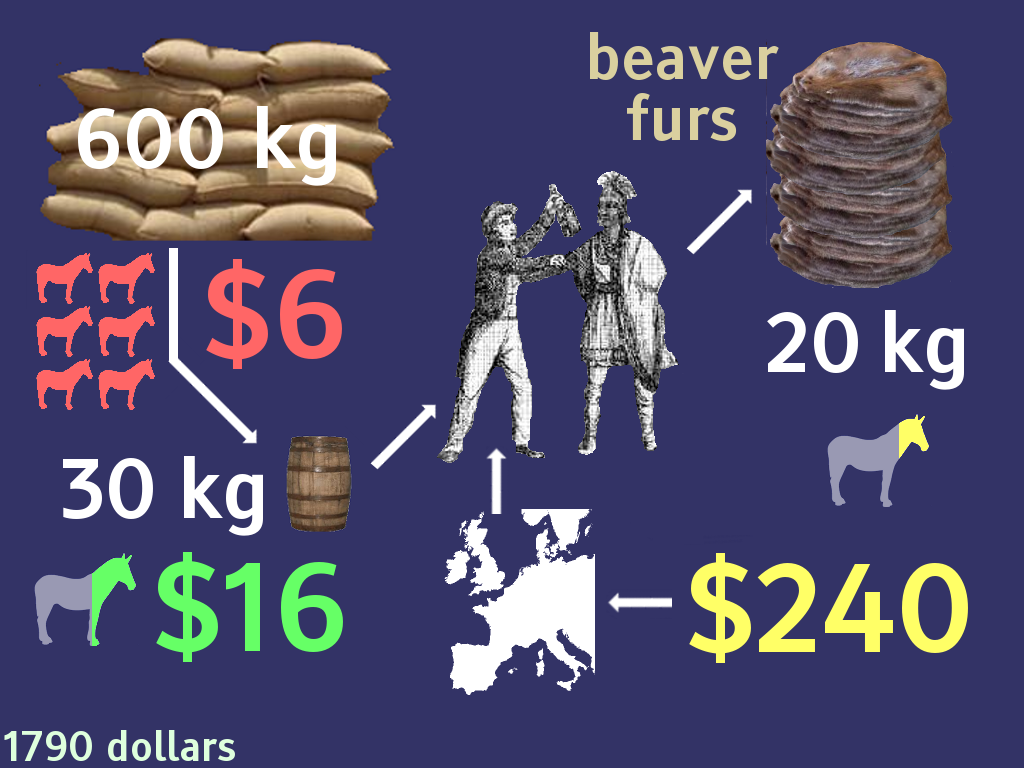Pioneers - are you as smart?
American pioneers crossed the Alleghenies into western Pennsylvania to take land, escape orthodoxy, avoid the law, and get rich growing grain. |
Early American pioneers (and modern Chinese exporters) knew something that too many space pioneer wannabees haven't learned yet: Don't ship cheap raw materials expensively, ship high value goods cheaply. Real pioneers turned $0.01/kg grain into $12/kg furs to ship to Europe - a 1200 times improvement in value per transported kilogram. Are we as smart as those pioneers?
With clever engineering, beamed routing to high-demand markets, and smart timing, 2 kilowatt-hours of space energy might become 1 kilowatt-hour of terrestrial grid energy at 10 cents per kWhr (estimated peaking hydropower cost). Electricity is a cheap commodity, like grain, and space electricity competes with an even cheaper commodity - coal.
Information is valuable. Google mass-manufactures $20 worth of information products per kilowatt-hour, delivered to customers within reach of the global fiber internet. 2 KWhr can manufacture $40 worth of information products in space, a 400 times markup over cost of the energy if sold on the ground.
The energy cost of sending that information to Earth is tiny, even with very high path losses. I don't know how many terabytes Google moves per dollar - wild speculation follows. As I write this, a 4 terabyte disk drive sells for $100, and a $10 DVD movie is about 10 gigabytes. Let's assume that Google's $20 of information is ten terabytes, or ten thousand gigabytes, perhaps 500 times cheaper than a DVD movie, or 12 times cheaper than a 4 terabyte hard disk.
The "Shannon energy" of a bit captured by a receiver is ln(2) kT, about 20 milli-electron volts or 1e-29 kWhr per bit. 10 TB (with extra bits for error correction) is about 1e14 bits, corresponding to a receive energy of 1e-15 kWhr. If the path loss was 120 dB, a factor of 1e12, then the transmit energy needed to move ten terabytes to earth is 1e-3 kWhr, or 0.1% of the energy used to compute it. Moving "massless" bits isn't free, but can be close to that, even with very very high transmission losses. 10 dB - a factor of 10 loss - is an economic showstopper for space solar power as currently envisioned (I assumed 3 dB or 2x loss above).
Both space power and space information have an important advantage over terrestrial power and information networks. Beam products can be delivered anyplace a satellite can see, not merely to locations connected to reliable electrical and information networks. 5 GHz microwave beamed power requires enormous antennas at both ends for efficiency, but beamed information can tolerate vastly lower efficiencies, allowing for much smaller antennas at each end (1 million times smaller in area for the example above).
Above 5 GHz, atmospheric losses to the ground become signficant, and interference with other services using that spectrum is unacceptable. Interference from power satellites will be unwelcome, but data communication uses vastly less power, and point-to-point transmission can use smaller spot size at higher frequencies, easily compensating for high path loss.
There are other options for space solar power - 183 GHz beams to stratospheric rectennas is one, shrinking the antennas at both ends 1400x in area compared to 5 GHz. Without blooming, and with heat conducted to the -50C stratosphere and then directly to space, power densities of 10 kW/m2 may be possible, so a 1 hectare antenna could capture 100 MW, and power a small town, or a military base, 20 km below - anywhere between 60° north and south.
But that will have to wait, just as American grain shipments to a starving world began more than a century after the pioneers turned grain into beaver furs, and sold them to the highest bidder. Profit pays for infrastructure. 70 years of government subsidized space activity has not created a spacefaring civilization, just bigger bureacracies. Let's try something else.
Stubborn adherence to ancient ideas is religious orthodoxy, not innovation. Pioneers - scoundrels, heretics, and outlaws - fled from orthodoxy. We should do likewise.

